6 Causes of Blank Film
6 Causes of Blank Film
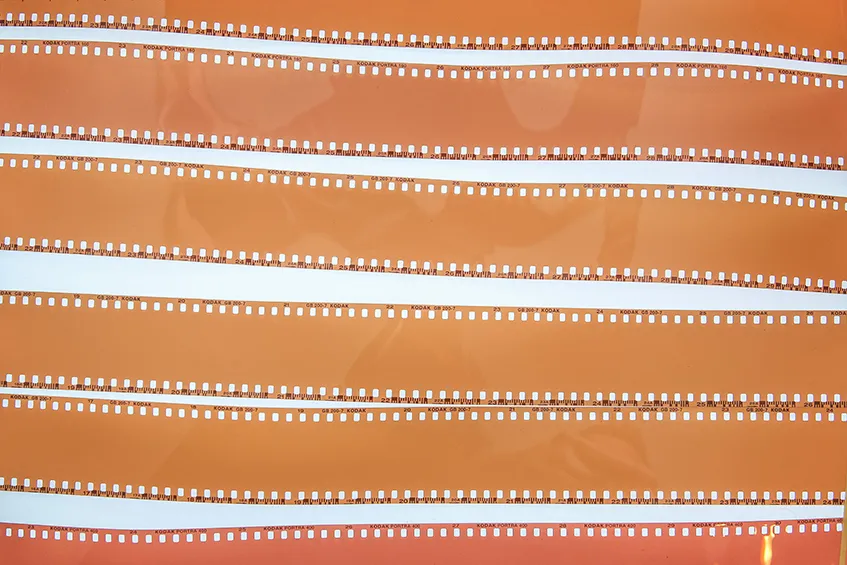 Six rolls of blank 35mm colour with no photographs on the film edge markings
Six rolls of blank 35mm colour with no photographs on the film edge markings
You’ve just shot a roll of film. Maybe you spent the day shooting sweeping landscapes or capturing moments with
friends or, you have a load of disposable cameras from a wedding or party. No matter what you shot you can’t wait to
see what amazing images you’ve captured. Away it goes to the lab to be processed.
Then you get the dreaded phone call or email - it’s blank! Or mostly blank. Even a few missed frames can be
incredibly disheartening. But, unfortunately, if you’re shooting film this is going to happen to you a t some point.
Personally it’s happened to me more than I care to admit.
But all hope isn’t lost. There's a few reasons why this can happen and most are easily solvable once you know what
you’re looking for. Although this doesn’t help with your current roll it can help you ensure your next roll and all
the ones after that won’t be lost to the same fate.
Common Causes of Blank Film
This is a list of some of the common causes of blank film. We’ll delve into these in more detail and explain what you
can do to prevent it. Some of the main causes are:
- Extremely over/under exposure
- Camera malfunction
- Incorrect camera settings
- Film not loaded correctly
- Camera opened while shooting
- Old/badly stored film
All of the above are extremely common but also extremely easy to solve. But first things first . . .
Mark the lab off the list
 Negative strip showing two correctly exposed and two under exposed photos
Negative strip showing two correctly exposed and two under exposed photos
The most important thing with shooting film is if you aren’t processing it yourself is that you are sending it to a
professional lab. This will ensure you’ve eliminated one place where a potential error may occur. Mistakes do
sometimes happen, that’s the nature of film, but a good professional lab you trust will always make sure that
everything has been double and triple checked on their end of things to ensure this is only an extremely rare case.
And, they will always be open and transparent with their customers and are willing to communicate and clarify any
questions you might have.
The easiest way to make sure your lab has processed your film correctly is to check the edge markings on your
negatives. Film manufactures print (using light) relevant information on the edges of the film such as frame number,
film type, barcodes, etc. If this is clearly visible on the film then that means it has been correctly processed and
the fault lies elsewhere in the shooting process. The example below shows typical edge margins you would expect to
see on a correctly processed roll of film.
 Negative strip showing two correctly exposed and two under exposed photos
Negative strip showing two correctly exposed and two under exposed photos
Over/Under exposure
This is probably the most common reason for blank frames on a roll of film. It’s an incredibly simple thing to happen
to you, whether you’re shooting your very first roll or you’re a seasoned pro with decades of experience under your
belt.
There’s numerous reasons this can happen. Such as incorrect settings for the scene you are shooting, mechanical
issues with the camera you are using, using slower speed films in darker conditions, the flash not firing or even
having the lens covered. These can happen to everyone no matter what stage they are at so don’t get disheartened.
All of the above have happened to me in the 10+ years I’ve been shooting film more times than I’d like to admit.
Camera Malfunction
 Six rolls of blank 35mm colour with no photographs on the film edge markings
Six rolls of blank 35mm colour with no photographs on the film edge markings
I guess you recognise this image from the very start of this article. That about half of the rolls of film from a
horror story of a malfunctioning camera. In total there were 12 blank rolls all from one malfunctioning camera.
It’s important you know that what you are shooting with is fully functioning. There may be a consistent fault
with it
that would result in the entire roll being bank. Other times there may be a gremlin causing an intermittent
fault
that will result in maybe a frame here and there not exposing correctly or, a few frames in a row.
Another extremely common fault isn’t necessarily a malfunction but something to be aware of. Some makes and
models of
film cameras will automatically revert to a “mechanical setting” for their shutter speed if the battery of the
light
meter dies. This means the camera may be fixed at one shutter speed. It’s something that can be very easily
overlooked when you’re shooting. And, depending on the lighting conditions, can result in images being
incredibly
under or incredibly over exposed.
The best advice to prevent this from happening is to make sure your camera equipment is in good working order
before
shooting. And, if you are unsure, definitely don’t shoot 12 rolls of film with it. If it’s a camera new to you
then
it’s always a good idea to shoot a test roll and see after that.
Incorrect Camera Settings
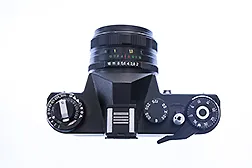 Top view of a black Zenit ET camera showing the main 3 settings - Shutter Speed, Aperture & ISO /figcaption>
Top view of a black Zenit ET camera showing the main 3 settings - Shutter Speed, Aperture & ISO /figcaption>
There’s lots of elements you have to consider when taking a photograph. Light, composition, shutter speed, aperture,
ISO, the list could go on. So it’s very easy to miss something, particularly if you’re moving between different
lighting quickly. If you go from a bright sunny day outside to dark indoor conditions and don’t compensate with
adjusting your setting or using additional light such as flash then you are going to end up under-exposing your
shot. The same is true in reverse. It’s always important to be aware of this.
One of the more important settings for shooting film is the ISO of the film. You change this when you change to a
roll of a different film sensitivity. This makes sure your light meter in the camera is metering for the correct
film speed. But it’s very easy to forget this when swapping rolls. If this does happen not all is lost. Shoot the
rest of the roll on the same ISO setting and when handing it in, inform the lab what ISO the film was shot at and
they may be able to pull or push it as necessary. Incorrect ISO setting may also cause some frames to be exposed
correctly while others are either over or under exposed depending on how your camera metered for that particular
lighting.
In the case of disposable or “simple use” film cameras you don’t have the option to adjust settings and in some cases
you might not even know the ISO of the film you are using. In this case the best rule of thumb is when in darker
conditions use the in built flash. But in these cases it may be necessary to manage your expectations in terms of
what may or may not come out.
Film Not Loaded Correctly
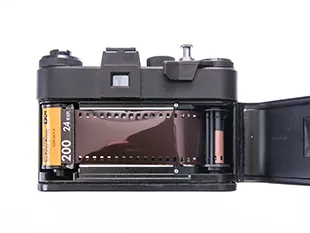 Top view of a black Zenit ET camera with the film rewind knob highlighted in red
Top view of a black Zenit ET camera with the film rewind knob highlighted in red
It’s key to ensure that the film is loaded correctly into your camera before shooting. If it hasn't engaged
properly
on the take up spool this will result in the film not advancing and not being exposed when the shutter
fires. This
will result in a completely blank roll of film after it has been processed.
Sometimes you may notice this has happened when you advance beyond the 36th or 37th frame. If you can keep
winding on
and firing it means that the film wasn’t correctly loaded. You may have lost the images but you will still
be able
to shoot the film once you load it correctly.
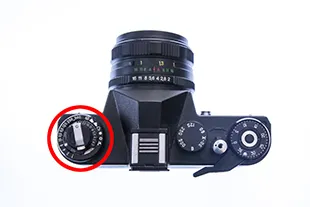 Rear view of a black Zenit ET camera with Kodak 200 ISO 35mm film correctly loaded
Rear view of a black Zenit ET camera with Kodak 200 ISO 35mm film correctly loaded
A good way to double check the camera is correctly loaded is to make sure the film rewind knob (highlighted
in the
photo) is turning. Once you close the camera back and begin to advance the film it will take up the slack
and should
begin to rotate after you’ve advanced 2 or 3 frames.
The best thing to do if you are unsure how to load your camera is to either ask someone who has one or to
look up a
video tutorial for that particular make/model. No matter how experienced you are with loading film this is
always a
good practice when getting to grips with a camera.
Camera Opened When Shooting
 A 35mm negative strip showing an example of light leaks across the film from the camera being opened mid roll
A 35mm negative strip showing an example of light leaks across the film from the camera being opened mid roll
Sometimes no matter how careful we are with double checking our equipment, loading the film and our settings while
we’re shooting something can still go wrong or we can still make a mistake. And opening the back of the camera is
one of them. Possibly you haven’t shot that camera in a long time and you open it thinking that there isn’t film
loaded. Maybe the latch fails and the back pops open or it gets dropped and pops open. These could happen to anyone
anytime. Unfortunately this means some, but not all, of the film is going to be damaged.
The film in the canister will still be okay to shoot but any that has been wound on will be affected to varying
degrees. The frames shot just before the back was opened will invariably be lost and there may be light leaks on
other images.
This is one of those things that even doing everything right can still happen. But to be sure, always make sure that
the camera is either empty or the film is fully wound back into the canister before opening. Check the latch on the
camera back, if it is loose then consider having it repaired. But if worst comes to worst you can always tape it
shut.
Old/Badly Stored Film
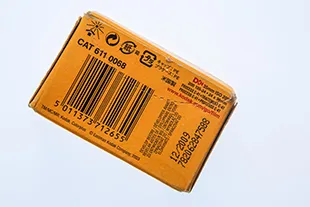 Rear view of a box of Kodak 200 expired film show the date it needed to be processed by
Rear view of a box of Kodak 200 expired film show the date it needed to be processed by
Film isn’t just sensitive to light. Lots of other factors affect it as well and these can result in results that may
cause a partial or completely blank roll of film.
New, fresh films can be adversely affected by extreme heat. This can cause fogging of the film, meaning your images
will be very flat and lack detail and look darker than they should. It’s best if you are not going to shoot a roll
of film for some time to keep it in a cool dark place. This will help ensure the longevity of the film and guarantee
good results when it is processed.
If you are shooting and processing expired film or film that you don’t know how it was stored then it is important to
be aware that the results of the film could vary drastically. Film emulsions can break down over time and in
different ways. This can cause colour shifts, extreme grain, and in some cases the images that were perfectly
exposed at the time may have deteriorated to the point that they are bordering on unusable.
When dealing with older films or badly stored films there’s a lot of variables with them and a lot of the time you
may not even know what they are.
The Wrap Up
Blank frames or even a blank roll of film is always disappointing. You’re always going to wonder what could have
been. But, it may not be much of a consolation, every film photographer has been through it. It’s almost like a
right of passage. And, no matter how much experience you have it can still happen. Just don’t get too disheartened
when it does. If you follow our advice above and you’ll be on solid ground to make sure every roll you shoot has the
best chance of delivering exactly what you want.
Get Shooting
We’ve got a great selection of 35mm and Medium Format film available in our Online
FIlm Shop and we offer a full range of Film Development. With, cumulatively,
50 plus years experience between us under one roof you know your film will be in good hands when you send it to us.
Get in touch!
We love hearing from you and want to make sure we’re doing everything we can for you to have the best Printpoint
experience! If you have any thoughts, comments, questions, or there’s something you’d like to see at Printpoint
email us anytime at info@printpoint.ie and we’ll be more than happy to help.
Don’t forget to follow us on Instagram for all our latest
news, offers and competitions. And don’t forget to tag us so we can see your amazing photos
Written by: Caleb Purcell
Photos by: Caleb Purcell
12/09/2021 22:58